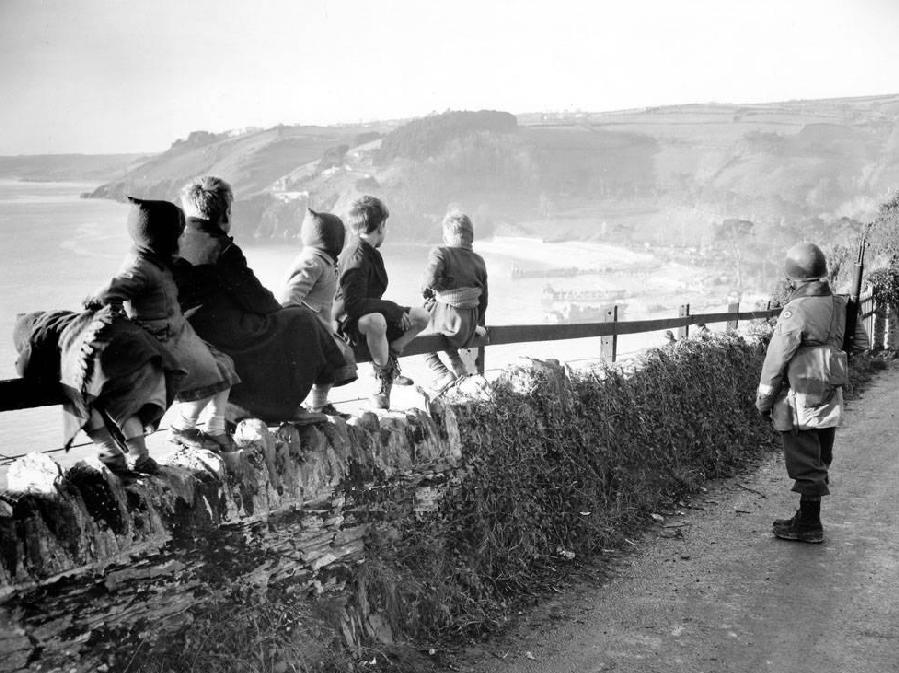
D-Day Buildup and Preparations: Training

Figure 1.--Here six English children and a guard are watching an American landing training on the Blackpool Sands ranges below. Blackpool Sands is a beach at Dartmouth, Devon along the Channel Coast. The photo shows units engaged in practicing the unloading of LCTs and LSTs, although the are difficult to make out, but are there if you look closely. The children are fascinated by all the equipment and activity down below on the beach. Notice the elf-type headwar that the girls are wearing. By the way the children are dressed, we would guess that it was Winter 1943-44.
|
|
Months before the invasion, the millions of Allied soldiers (America, British, Canadians, Free French, Poles, and others) engaged in intensive training, often highly realistic exercises. Many of the American divisioins in particular had no combat experience. The Allied D-Day training effoty was a vital and vast endeavor. Some of it was conducted in North America, but most of it was conducted in England, a good deal of it especially the most realistic exercvises along the southern coast. There were bases opened all over the country. The British and Canadian bases were mostly in eastern England because the Germans had been expected to land along the southeastern coast. The American bases were in western England because this was where space was available. Firing ranges were at a premium, as such large areas were needed for practice-firing weapons, especially heacvy weapons. The emphasis ftom the beginning was on amphibious operations because beach landing was the critical point of the whole operation. Here the bortive Deppe Opperation (1942) had made a critical difference. The German conclussion was that the Allies were coming for the pports. Thus they heavilt defended the ports. The Alklies concluded atht the ports were too hard a target and thus chose lightly defended beach sites and brought their ports with them--Mulberries. Even more important because the Amerivan Mulberry was destroyed were the landing craft, Higgins Boats and Landing Ship Tanks (LSTs). In one training exercise, German E-boats shot up several LSTs with serious losses. While the gratest concentration of bases was in southern England, there wee training facilklities all over the country, including Scotland. A particularly important base was the British Combined Operations Training Center at Inverary noth of Glasgow. It had been established at the onset of the War (1940). The initial purpose to train for commando operations, but expanded when British priorities changed from raisd to a massive invasion. Then bases in southern England were opened such as Culbin Sands and Burghead Bay to prepare in the actual areas where the Allied invasion fleet would assemble. The U.S. Army set up at least eight training centers preparing for D-Day. Woolacombe Beach, Devonshire was an important Assault Training Center. Actual amphibious training was conducted here, in part because of the topographical similarity to Normandy. Slapton Sands in South Devon was used for amphibious rehearsals. It bwas here the costly Operation Tiger was conducted (April 1944). [Tillman] The United States had learned a great deal about amphibious operations (1942-43), but the men landing mostly hd no experience. The training exercises gave the commanders and men actual experiece and the opportunity to identify issues and problems as well as time to correct them before the actual landings. The first training exercise that was conducted in Devon experiebced a range of problems, especially troop communications. A general sense of chaos was reported along with a lack of understanding of the overall mission. A massive full-scale American rehearsal was coducted along the Devon coast using 23,000 troops. There were also training exercises in Florida at Camp Gordon Johnston. An essential element of the training was to ensure that the Army, Navy and Air Forces coorinating operations. An official Combined Service Centre was established to help the three military units work together more efficiently and effectively. Here naval coordinatiin was especially worked out. American tactical air operations were still being worked out and were not in place until shortly after the landings.
Sources
Tillman, Barrett. D-Day Encyclopedia (2014).
CIH -- WW II

Navigate the CIH World War II Section:
[Return to Main D-Day build up and preparation page]
[Return to Main D-Day page]
[Return to Main Anglo-American Alliance page]
[Return to Main United Kingdom World War II page]
[Return to Main United States World War II page]
[About Us]
[Biographies]
[Campaigns]
[Children]
[Countries]
[Deciding factors]
[Diplomacy]
[Geo-political crisis]
[Economics]
[Home front]
[Intelligence]
[Resistance]
[Race]
[Refugees]
[Technology]
[Bibliographies]
[Contributions]
[FAQs]
[Images]
[Links]
[Registration]
[Tools]
[Return to Main World War II page]
[Return to Main war essay page]
Created: 3:27 AM 7/15/2019
Last updated: 3:27 AM 7/15/2019



